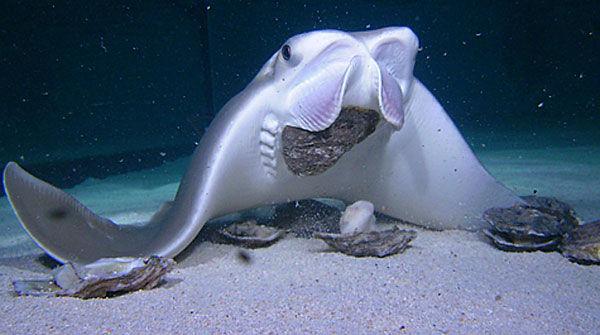Appearance

Scientific Name
Rhinoptera bonasus
Market Forms
Fresh fillets (average 2 lbs.), loins (average 2 lbs.), wings (average 10 lbs.), Frozen fillets, loins, wings are available year round. Size
Large ray - 20-40 pounds
Small ray - 10-15 pounds Taste/Texture
Tender meat with beefy flavor. Its color is comparable to tuna before and after cooking. Ray, sometimes called “Veal of the Sea”, is a new product for the food service market. Ray has all the benefits of fish without the fishy taste. Seasonality
Also known as a cownose ray, it is found in the Chesapeake Bay and East Coast waters from May till late September. Nutritional Value
91 Calories (100 grams, 3.5 oz.)
Protein 20 grams
Fat 0
Omega 3 70 mg. Substitutability
Veal, Flank Steak Habitat
Western Atlantic, Southern New England to northern Florida throughout the Gulf of Mexico. Folklore
In 1608, Captain John Smith, learned about the nature of a Chesapeake Ray. While Smith was spearing a ray with his sword near the Rappahannock River, the ray defended itself by striking Smith in the shoulder with its barb, located on the base of its tail. The pain was so terrible that the crew was convinced Smith was dying, so they dug a grave for him. But he overcame the pain and felt well enough that evening to eat the ray for supper. The place this happened is still known as Stingray Point, located in Deltaville, VA. Harvesting
Chesapeake ray are harvested by day boats using pound and gill nets. Environmental Statement
Chesapeake ray eat clams, lobsters, oysters, bay scallops and crabs There is concern that rays are harming the oyster, clam, bay scallop and clam aquaculture population. Rays also destroy sea grass beds. Chesapeake ray are not threatened. Safety/Quality
Virginia’s waters and products are regulated by federal and state agencies including the FDA, the Virginia Department of Health, the Virginia Department of Agriculture and Consumer Services, the Virginia Department of Environmental Quality, and the Virginia Marine Resources Commission, insuring that only safe wholesome seafood reaches our customers.

